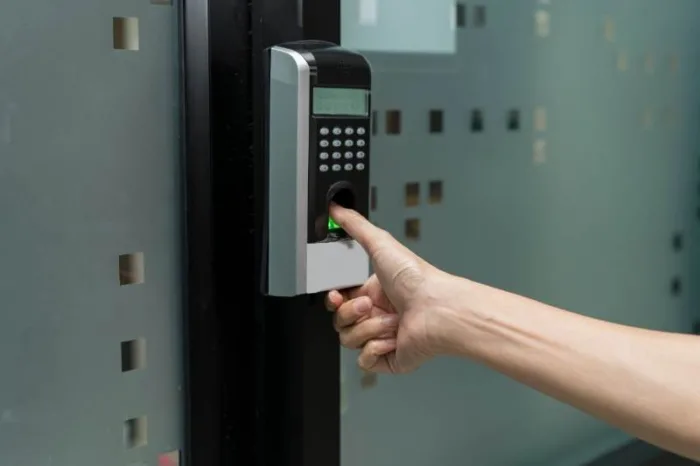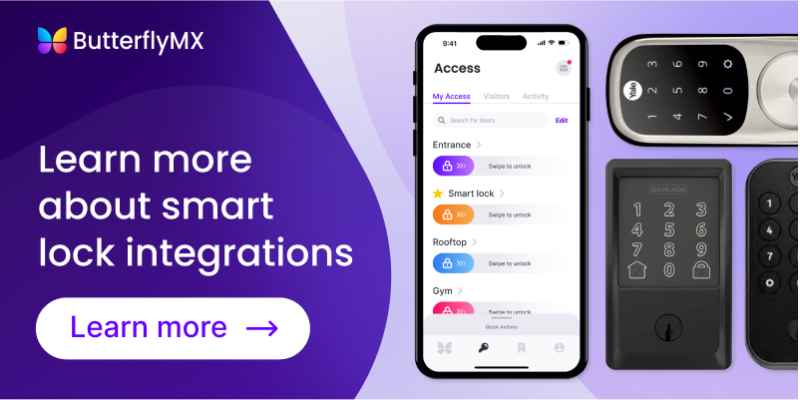Key takeaways
- Biometric door locks utilize a user’s body as a credential.
- While secure, biometric locks have a high possibility of user error and may introduce privacy concerns
- The four major types of biometric locks are fingerprint readers, facial scanners, iris scanners, and voice recognition locks.
- The best biometric lock alternative is the ButterflyMX Keypad because of its advanced security features and how it simplifies guest access.
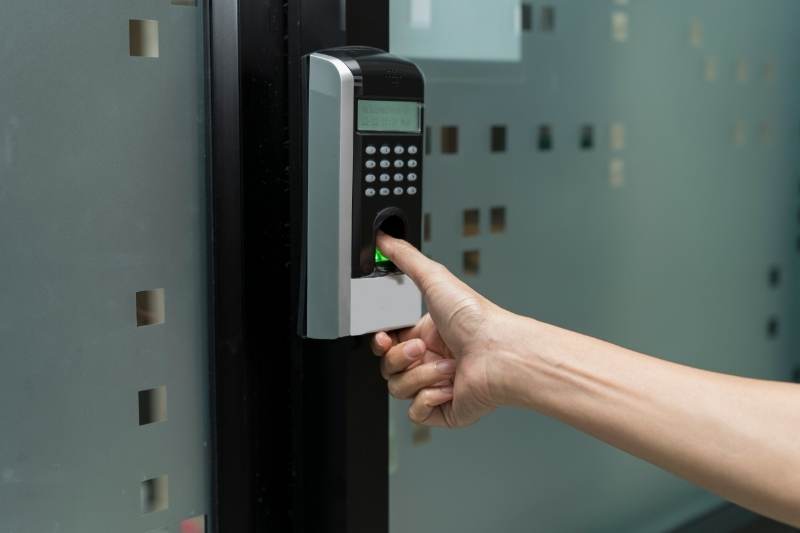
When upgrading your building’s locking systems, you’re also going to want to modernize them. Biometric door locks feature cutting-edge technology that allows users to scan their fingerprint or other types of biological credentials to unlock the door.
Biometric locks might be a good option for your property. However, every property has unique needs. So, it’s important to learn whether biometric door locks will benefit your building before purchasing them.
This guide goes over what a biometric door lock is and how it works. Next, we’ll explore the different types of biometric door locks. Finally, we’ll cover the best biometric lock alternative for your building.
This post covers:
- 3 best biometric door locks to buy
- What is a biometric door lock?
- How do biometric locks work?
- Types of biometric door locks
- What are the pros and cons of biometric locks?
- What is the best biometric door lock alternative?
3 best biometric door locks to buy
The best biometric door lock to buy will depend on the unique needs of your property. Not every door lock will work for you, so it’s important to explore a wide variety.
The top biometric locks are:
1. Eufy Security Smart Lock
Eufy is a brand under Anker Innovations, known for its reliable and user-friendly smart home products.
Features:
- Biometric fingerprint scanning with a high recognition rate that allows you to scan and enter the building faster.
- Keypad and app-based access as an alternate method of entry.
- Remote control via the Eufy Security app.
- Built-in rechargeable battery with a long lifespan that allows you to go longer without changing your batteries.
- High-grade zinc alloy construction for outdoor durability.
2. Ultraloq U-Bolt Pro
Ultraloq is a company focused on smart lock solutions, providing innovative security technologies.
Features:
- Fingerprint recognition with a 360-degree sensor that scans your fingerprint faster.
- Multiple access methods: fingerprint, keypad, smartphone app, and mechanical key
- Weatherproof design.
- Easy installation that can be done yourself.
- Includes an optional bridge for remote access from your mobile device.
3. Samsonite Biometric Lock
Samsonite is a renowned brand known primarily for luggage but has expanded into smart security solutions.
Features:
- Fingerprint scanning with quick access that is faster than manually inputting a code.
- Compact design that is ideal for small doors and safes.
- Long battery life with easy-to-replace batteries results in you having to do less maintenance on the device.
- Robust construction for durability, especially if your lock is placed outdoors in a place with inclement weather.
What is a biometric door lock?
Biometric door locks are a type of keyless lock that uses a unique part of a user’s body as a credential.
Biometric locks for doors take the form of:
- Fingerprint scanners
- Facial scanners
- Iris scanners
- Voice recognition software.
How do biometric locks work?
A biometric lock typically works by scanning a user’s finger, face, eye, or voice. The reader processes these credentials before electronically releasing the locking mechanism.
Biometric locks can store more than one user’s credentials, which means they work for both multifamily and commercial properties.
Additionally, most biometric door locks also have a numeric keypad where users can enter a PIN code. This is often in case of user error.
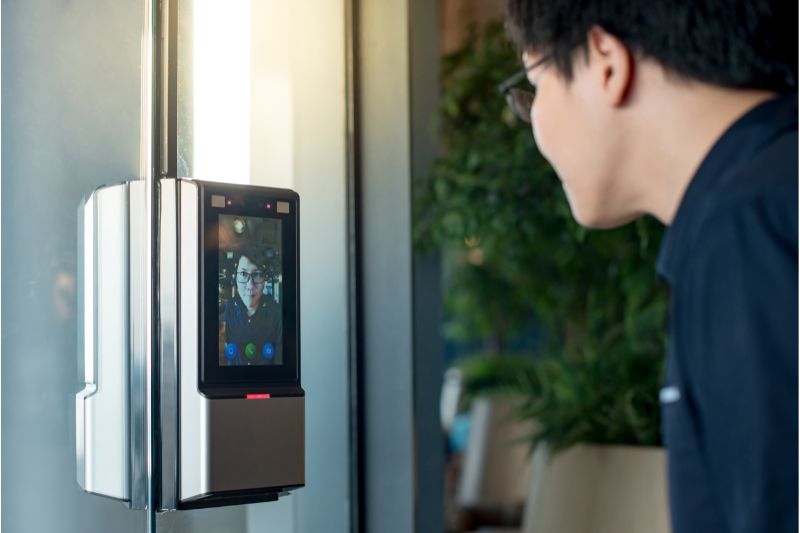
Are biometric door locks secure?
Biometric door locks are as secure as most other commercial door locks. It’s very difficult to fake the unique biological characteristics of a user who is registered to a biometric lock. What’s more, many biometric locks come with a camera to further enhance security.
Is biometric unlocking safe?
A major weakness of biometric locks is that the technology isn’t flawless.
For example, facial readers can have trouble scanning someone’s face if the lighting is bad or the person’s face is obscured. Voice recognition software can also have trouble if there’s too much sound interference. This room for human error can lead to an authorized tenant being denied entry to a room or building.
That said, most biometric deadbolts feature an alternative entry method, such as a PIN code.
Another weakness of biometric locks is that they pose privacy concerns for tenants. Many people find the technology to be invasive and don’t want to share their fingerprints or other biological credentials with building management.
Types of biometric door locks
Currently, there are four types of biometric locks that are widely used. Some biometric door locks will work better for certain properties than others. And all of them have unique pros and cons.
The four types of biometric locks are:
Fingerprint door locks
These are by far the most common biometric lock. In addition to facial scanners, many users are already familiar with how fingerprint locks work since fingerprint readers are used in smartphones.
Fingerprint door locks are likely useful for both multifamily and commercial properties because of how easy they are to use and how familiar users already are with them.
The fingerprint door lock price runs between $40 and $2,000, depending on the type of lock you purchase.
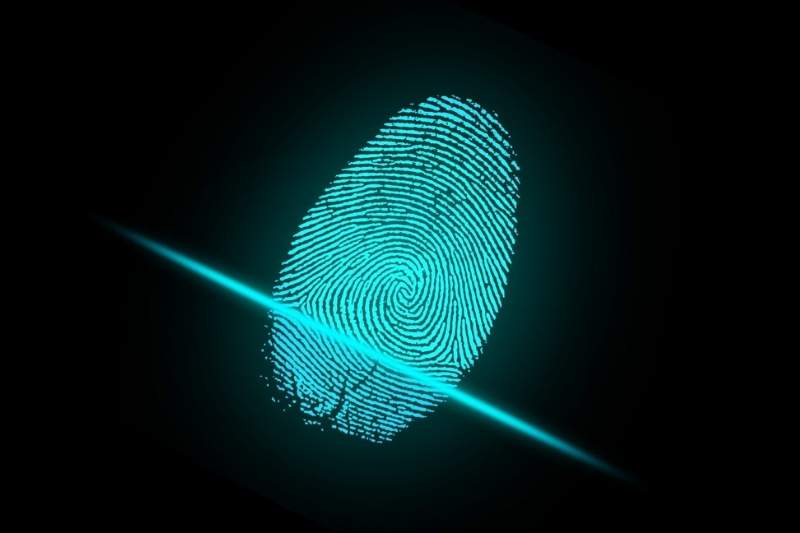
Facial scanners
Facial scanners are extremely similar to fingerprint door locks, though they’re a little less common. Currently, the technology is continuing to be optimized by AI. They work by analyzing the unique shape of a user’s face.
Low lighting can affect their accuracy, so this is an important factor to consider when installing them in your building.
Facial scanners are a bit pricier than fingerprint door locks and run between $200 and $6,000.
Iris scanners
Eye scanners, made popular in spy movies before they were available to the general public, aren’t very common biometric locks.
Like facial scanners, eye scanners offer a form of contactless entry, preventing the spread of germs on a control panel. Low light can also affect their accuracy.
Iris scanners cost between $500 and $5,000.
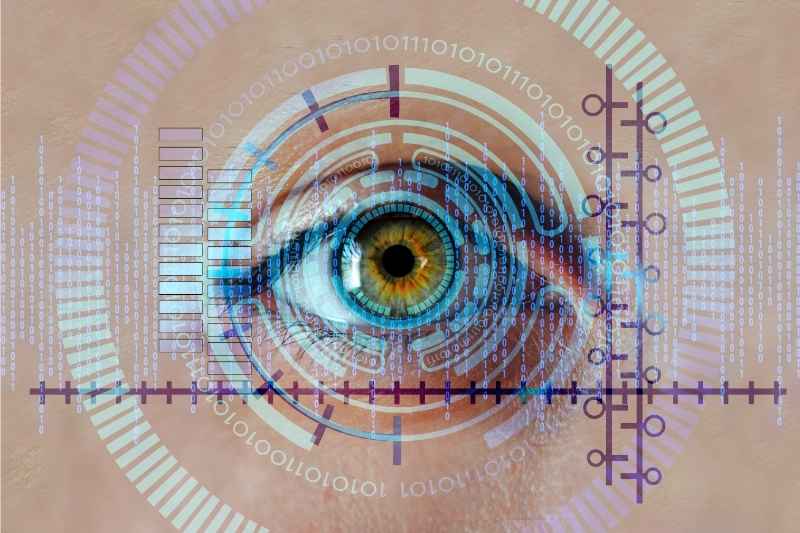
Voice recognition locks
These locks recognize the unique vocal patterns of users. Loud noises and other people speaking at the same time as the user can lead to errors. A user will usually say a phrase to activate the lock, such as, “Unlock the office door.” Of course, other passwords and phrases can be programmed.
Voice recognition locks cost between $90 and $700. This puts them as the second most affordable biometric lock next to fingerprint door locks.
What are the pros and cons of biometric locks?
Biometric locks are useful in a number of unique ways, but are they the perfect fit for your property?
Pros:
- Unique identification. Provides a high level of security since biometric traits are unique to each individual.
- Difficult to forge. Harder for unauthorized users to replicate biometric data compared to traditional keys or codes.
- No Keys Needed. Eliminates the need for physical keys, reducing the risk of losing or misplacing them.
- Fast Access. Allows quick entry with a simple scan or recognition, saving time compared to using keys or codes.
- No memorization required. Removes the need to remember or manage codes or passwords.
Cons:
- Single family. Biometric locks can only be programmed with so many different inputs. As a result, they’re not useful for multifamily properties with a large number of users.
- Higher price. Generally more expensive than traditional locks due to advanced technology.
- Technical issues. Can occasionally fail to recognize authorized users, especially with changes in physical conditions or sensor issues.
- Malfunctions. Potential for technology failures, such as sensor or software issues.
- Privacy Concerns. Biometric data is sensitive and could be targeted by hackers, raising privacy risks.
- Battery Dependency. Many are battery-operated, so they can become inoperative if the battery dies, necessitating replacement or recharging.
Learn more about how to control access with ButterflyMX:
What is the best biometric door lock alternative?
The best biometric door lock alternative is ButterflyMX. The ButterflyMX access control platform enables property-wide access throughout your property, from the front door or gate to the elevators, amenity spaces, and individual apartments.
Key features of the ButterflyMX include:
- Remote access. Building occupants no longer have to be present to allow guests and other personnel into the building. Users can grant remote entry to anyone they choose from the ButterflyMX mobile app. Temporary PIN codes can also be given to guests as well.
- Smart Locks. Integrate your ButterflyMX Access Control with a wide range of smart locks so residents can access the entire property through a single mobile app, improving convenience and security.
- Mobile app. This does away with physical access credentials and allows users to unlock a door by tapping a button on the mobile app.
- Cloud-based technology. This cuts down on maintenance costs and manual programming by allowing automatic software updates.
- Date- and time-stamped entry. Every time someone enters the building, the ButterflyMX Access Control System logs the exact date and time. This is useful data to monitor should any incidents occur.
- Multiple credentials. ButterflyMX supports a variety of credentials, such as our mobile app, PIN codes, key cards, and fobs. This way, you and your residents can use your preferred credentials for maximum convenience.
